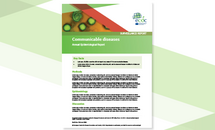Diphtheria - Annual Epidemiological Report for 2022
In 2022, 359 cases of diphtheria due to toxigenic Corynebacterium diphtheriae (n=318) or C. ulcerans (n=11) were reported to ECDC.
Executive Summary
- Since the second half of 2022, an increase of diphtheria among migrants was reported in several EU/EEA countries, with peaking case numbers in September to December.
- The highest proportion of C. diphtheriae cases was among 15- to 44-year-old males. C. ulcerans cases were more common in adults aged 65 years and above.
- Among C. diphtheriae cases with importation status available, 62% were reported as imported (having been outside the country of notification during the incubation period with no links to local transmission), with 78% of the imported cases presenting with a cutaneous infection.
- Vaccination status was available for 39% of all cases. Seventy-five percent of the cases with known vaccination status were not vaccinated or were vaccinated with an unknown number of doses.
- Vaccination with the diphtheria toxoid vaccine is the only effective method of preventing the toxin-mediated disease. Achieving and sustaining high vaccination coverage in the population is critical for preventing toxigenic diphtheria from causing serious or fatal illness.
Download

Diphtheria - Annual Epidemiological Report for 2022
- EN - [PDF-923.16 KB]







